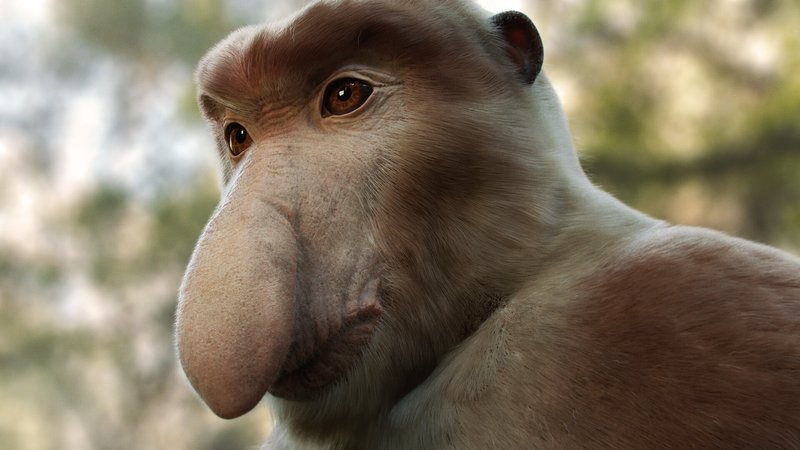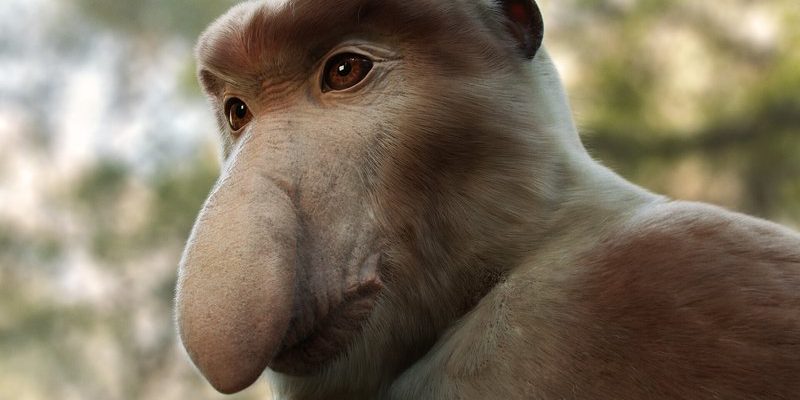
The proboscis monkey, or *Nasalis larvatus*, is native to the dense mangrove forests of Southeast Asia, particularly in Borneo and Sumatra. They’ve been around for a while, and their evolutionary story is as wild as they are. Let’s dive into how this quirky primate came to be, exploring their characteristics, habitat, and the challenges they face today.
Understanding the Proboscis Monkey’s Unique Features
One of the first things you’ll notice about the proboscis monkey is its impressive nose. Honestly, it’s hard to miss! The males typically have long, pendulous noses that can reach up to 7 inches. You might be wondering why they have such big noses. Well, this feature isn’t just for show—it’s a tool for communication. When males want to attract females or assert dominance, they take deep breaths and let out loud honks, making their nose resonate. It’s like nature’s version of a megaphone!
Besides their noses, these monkeys have a distinctive body shape and coloration. They sport a mix of reddish-brown fur with lighter underbellies and webbed toes, which make them excellent swimmers—yes, swimmers! Unlike many other primates, proboscis monkeys are quite comfortable in the water and often take to rivers to escape predators or forage for food.
The Proboscis Monkey’s Habitat and Range
Proboscis monkeys are primarily found in the lowland rainforests, mangrove swamps, and riverine forests of Borneo and Sumatra. Let me explain: these environments offer the monkeys ample opportunities for foraging. Their diet mainly consists of leaves, fruits, and seeds, with a preference for young leaves that are rich in protein.
These habitats are special in another way—they are incredibly biodiverse and play a crucial role in the ecosystem. When proboscis monkeys feed on leaves, they help many plant species by spreading seeds through their droppings. It’s a symbiotic relationship that highlights the importance of these monkeys in maintaining the health of their environment.
However, not all is well in monkey land. Their habitats are under severe threat from deforestation, agriculture, and human encroachment. This loss of habitat not only threatens their survival but also disrupts the delicate balance of the ecosystems they inhabit.
The Evolutionary Journey of the Proboscis Monkey
To understand how proboscis monkeys came to be, we need to look back at their evolutionary journey. They belong to the family Cercopithecidae, which includes Old World monkeys. Scientists believe that these primates diverged from their closest relatives, the macaques and baboons, around 16 million years ago.
The adaptation of their physical traits, particularly that notable nose, is a significant part of their evolutionary story. The sexual dimorphism—where males and females look different, especially regarding size and features—is thought to have developed to attract mates. It’s fascinating to think that such a prominent characteristic plays a critical role in their social structure and mating rituals.
Over time, proboscis monkeys have adapted to their unique ecological niche, emphasizing their need for a herbivorous diet and social living in large troops. Troop behavior enhances their chances of survival, offering protection from predators like crocodiles and large birds of prey.
Social Structure and Behavior
Proboscis monkeys are social animals and typically live in groups of 10 to 30 individuals. Their social structure usually comprises a dominant male, several females, and their offspring. Here’s the thing: the troops operate almost like a family unit, with everyone taking part in rearing the young and foraging for food.
These monkeys communicate in various ways—through vocalizations, facial expressions, and even body language. The loud honks and grunts are part of their social fabric and help maintain group cohesion. You could say that their whole existence revolves around teamwork, whether it’s finding food or keeping an eye out for danger.
Interestingly, proboscis monkeys are known for their quirky behaviors, like leaping from tree branches into water. This act isn’t just about play; it’s a survival tactic to escape threats. When you think about it, their behavior mirrors that of their environment—adaptable and resourceful.
Conservation Status and Challenges
Sadly, the proboscis monkey is classified as endangered due to habitat destruction, hunting, and the illegal pet trade. The ongoing fight for their survival isn’t just a matter of saving one species; it reflects broader environmental issues that affect many creatures in their ecosystem.
Conservation efforts are underway, with organizations working to protect their habitats and educate local communities about the importance of preserving these unique primates. It’s a challenging task because, as you can imagine, balancing human needs with wildlife conservation is no easy feat.
Efforts include establishing protected areas and promoting sustainable farming practices. Everyone has a role to play in conservation, from local communities to global organizations. Every small action counts, and raising awareness about the critical status of the proboscis monkey can help foster a brighter future for them.
The Future of the Proboscis Monkey
The future of the proboscis monkey hangs in the balance. It largely depends on our efforts to create a sustainable environment where these unique creatures can thrive. Here’s a thought: if we don’t act now, we might lose an extraordinary part of our natural heritage.
As we move forward, it’s essential to continue supporting conservation initiatives and promoting awareness about the plight of the proboscis monkey. Engaging with local communities and emphasizing the importance of biodiversity can turn the tide for many endangered species, including these fascinating monkeys.
Ultimately, the story of the proboscis monkey is not just about survival; it’s a testament to the interconnectedness of all living things. By protecting these incredible creatures, we honor the complex web of life they represent, and we take a stand for our environment.
In conclusion, learning about the evolutionary history of the proboscis monkey offers not just a glimpse into the past but also an opportunity to reflect on our responsibilities for the future. With each small action we take today, we can help ensure that this distinctive primate remains part of our world for generations to come.

